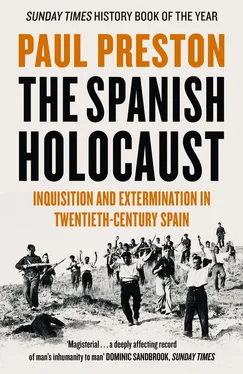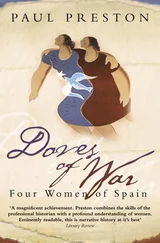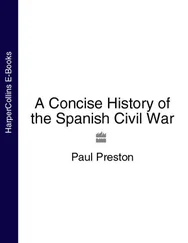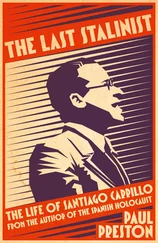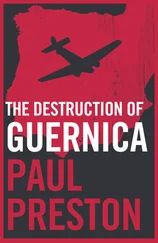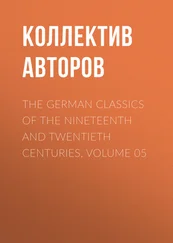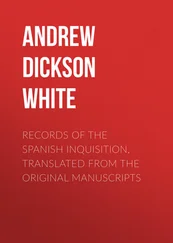Throughout June and July, Gil Robles instructed provincial CEDA leaders that, on the outbreak of the rising, all party members were to join the military immediately, party organizations were to offer full collaboration, youth sections were to join the army and not form separate militias, party members were not to take part in reprisals against the left, power struggles with other rightist groups were to be avoided, and the maximum financial aid was to be given to the authorities. Only the instruction about reprisals was ignored, and CEDA members were prominent in the repression, especially in Granada and the cities of Old Castile. The first section of the CEDA to join the rising was the Derecha Regional Valenciana. Its moderate Christian Democrat leader Luis Lucia had been marginalized by the secretary general, José María Costa Serrano. When General Mola was finalizing civilian participation in June, Costa Serrano offered 1,250 men for the early moments of the rising and promised 10,000 after five hours and 50,000 after five days. Alongside local sections of the Falange, Renovación Española and the Carlists, the radical wing of the DRV was placed by Costa Serrano under the orders of the military junta. At the beginning of the war, Lucia issued a statement condemning the coup. As a right-wing politician, he went into hiding from the anarchists only to be caught and imprisoned in Barcelona. Nevertheless, in 1939 he was tried and sentenced to death by the Francoists for the alleged offence of military rebellion. His sentence was later commuted to thirty years in prison. 117
Military intervention came to seem an ever more urgent necessity in the eyes of landowners as a result of the Socialist campaign for the recovery of common lands which enjoyed the support of the Minister of Agriculture, Mariano Ruiz-Funes. 118The rhetoric of the landowners, and that of their press, generated an apocalyptic sense of utter catastrophe. On 10 July, ABC lamented that 80 per cent of the land would be in the hands of municipalities and that there would be towns where private property would disappear. 119The younger members of landowning families joined the Falange. Anticipating the coup, many owners moved into their homes in the larger towns of the province, or to Madrid or Seville, or, in the case of the very rich, even to Biarritz or Paris, where they contributed finance and expectantly awaited news of the military plot. Behind them they left gangs of Falangists who attacked local Socialists with the protection of the Civil Guard. In Don Benito, the Civil Guard helped local Falangists when they firebombed the Casa del Pueblo. 120The FNTT frequently complained that the victims of the Civil Guard were always workers and denounced the stockpiling of arms by the landowners. It was claimed that, in Puebla de Almoradiel in the south of Toledo, the local right had two hundred shotguns, three hundred pistols and more than fifty rifles. 121When workers tried to collect unpaid wages from the landowners, they were often confronted by the Civil Guard. Those who had made such demands were invariably among the victims of the right-wing columns that captured their towns in the early months of the Civil War. 122
The hatred between the landless peasants and the owners and their administrators was part of daily life in the south. One major landowner from Seville, Rafael de Medina, wrote of ‘the incomprehension of the haves and the envy of the have-nots’, of those who walked in rope sandals (alpargatas) and those who travelled by car. As he and his father drove past labourers walking along a country road, they noted their ‘grimfaced look, of such profound contempt and such outright bitterness, that it had the force of a thunderbolt’. Medina always carried a pistol at meetings to discuss working conditions with union leaders. 123
The hatred was explained by the Civil Governor of Seville, José María Varela Rendueles. Many of the really big owners, dukes, counts and even very rich non-aristocratic owners, lived in Paris or Biarritz or Madrid. They visited their lands occasionally to hunt and to show them off to their friends. While there, their contempt for the labourers was manifest. They, like the less grand landowners who lived on their estates, would often laughingly take advantage of the wives, sisters and daughters of their labourers. Their administrators ran the estates, hiring and firing arbitrarily, ignoring the law. After the abuses of 1933–5, the return of left-wing town councils after the February 1936 elections saw a reversal of fortunes. The prevailing spirit was one not of conciliation but of outright hatred. As Varela Rendueles put it, the landless labourers wanted to follow the example of their ‘betters’: ‘all they wanted to do was to repeat the barbaric lessons that they had been taught’. 124
A key element of the hatred between the rural poor and the rich, Varela Rendueles noted, was the way in which proletarian women were used and abused. Baldomero Díaz de Entresotos expressed the patronizing and exploitative attitude of the rural middle classes when he wrote indignantly of those who tried to break free of the prostitution into which they had been forced:
You lived off the romantic adventures of the señorito … Those señoritos, once your friends, used to live for you just as you lived for them. You think they stole municipal funds? I don’t think so but if they did the people’s money returned to the people as represented by pretty proletarian women. The señoritos were unable to stay away. At siesta time, they came to your whorehouses, sat in their shirtsleeves in the shade of trailing vines and left you banknotes on the beer crates. They livened up the tedium of your nights with wine and music. They were real democrats. Is there any greater democracy than to sleep in the arms of the daughters of the people? Generous, truly Andalusian, señoritos. 125
The perception and empathy with which Varela Rendueles interpreted rural tensions was rare. In notes for his unfinished autobiography, General Sanjurjo made the revealing comment: ‘In reality, the agrarian problem in the name of which so many mistakes are made to the detriment of landowners and against the overall economy of Spain, exists only in Madrid on the lips of demagogues who use it as a way of exciting and manipulating the rural population. The agrarian problem was an invention of people like Margarita Nelken.’ 126
Mola had complained on 1 July that the planned spiral of provocation and reprisal had not persuaded public opinion to consider a military uprising legitimate. Less than two weeks later that goal was reached. On the evening of 12 July, Falangist gunmen murdered a lieutenant of the Assault Guards, José del Castillo Sáenz de Tejada. 127This crime derived much of its catastrophic impact from the fact that, two months earlier, on 7 May, Castillo’s friend Captain Carlos Faraudo de Miches had been shot dead by a Falangist squad. On that same day, the Prime Minister and Minister of War, Santiago Casares Quiroga, showed his adjutant, Major Ignacio Hidalgo de Cisneros of the air force, a right-wing blacklist of fourteen members of the Unión Militar Republicana Antifascista, which had been created in late 1935 to combat the activities of the UME. Faraudo was number one, Castillo number two and Hidalgo de Cisneros fourth. 128
After Faraudo’s murder, calls for reprisals had been silenced. However, when Castillo was also assassinated, fellow Assault Guards from the Pontejos barracks just behind the Dirección General de Seguridad in Madrid’s Puerta del Sol were determined on revenge. In the early hours of the following day, they set out to take revenge on a prominent right-wing politician. Failing to find Gil Robles who was holidaying in Biarritz, they kidnapped Calvo Sotelo and, shortly after he got into the truck, one of them shot him. His body was then taken to the municipal cemetery where it was discovered the next morning. 129Republican and Socialist leaders were appalled and the authorities immediately began a thorough investigation. For the right, it was the opportunity to launch the coup for which the lengthy preparations were on the point of fruition.
Читать дальше
